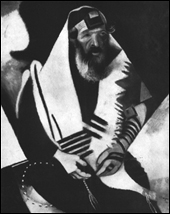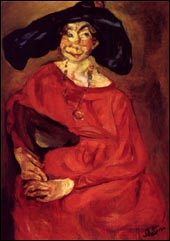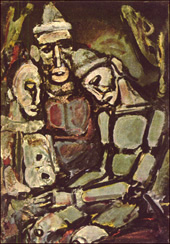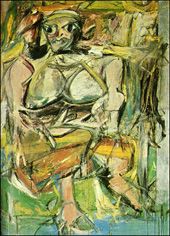
Writing: Thesis
I
Her 125-page M.F.A. thesis on “The Human Image in Contemporary Painting” (1959) is a brave and beautiful piece of work. God knows why something from it, chapter III for example, wasn’t printed in GSE (The Graduate Student of English), the quarterly that I was co-editing.
II
In the first three chapters she is concerned to define some of the disadvantages of excluding “life-values” from painting, and some of the problems facing the contemporary artist who wants to incorporate them into figure painting. After that she devotes a chapter each to Chagall, Rouault, Soutine, and De Kooning, essentially the De Kooning of the Women paintings, and concentrates on two or three works by each of them that successfully combine life-values and technique.
In the course of her argument, she draws comfortably on a variety of writers, over and above contemporary critics like Greenberg, Steinberg, and Venturi. Among those that she makes use of are Maritain, Collingwood, Buber, Jung, Gasset, Nietzsche, Auerbach, Malraux.
She refers to a lot of twentieth-century and late-nineteenth-century artists. Ensor, Munch, and Kokoschka are there. She calls them “great painters.” Bonnard is there. Rousseau is there. Ernst is there (though at that time she didn’t think much of the Surrealists.)
III
The prose is consistently firm and lucid.
I expect that at some point she asked me to read a draft of the thesis. I’m sure, though, that any changes that I suggested concerned very minor points of style. So too with her article in GSE on the appeal of Gibran’s The Prophet, which admirably displays her verve and vigour.
It may be that she had been influenced to some extent by dipping into the pages or proof-pages of GSE, of which she was technically the managing editor for a year or so. We made a big point of clarity in that journal. But I think she had a naturally clear mind, and in some ways she was more of an intellectual, in the European fashion, than any of the editors, myself included.
She was not afraid to make large generalizations about large issues. Later on she would refer dryly to “MFA prose,” but she was being too self-depreciatory.
IV
I shall not try to summarize her argument. Instead I shall quote some passages that display her intellectual and stylistic strengths. The two can’t be separated.
As I have done elsewhere, I shall split up paragraphs in the interests of readability. Reading on-screen isn’t the same as reading on paper.
V
On representation
There is a kind of painting which seeks to clarify and communicate life experiences by linking up the artist and whoever sees the paintings, through explicit and recognizable images, with our cultural reality. In modern art, however, most of this painting is very unsuccessful.
Either the artist is so intent on creating new images (at the expense of the process), that his paintings turn into the embarrassing and pretentious kind of illustration that is exemplified by the paintings of Albright, Levine, and Peter Blume. Or he is so intent on being “modern” that he adopts a modern technique (at the expense of the images) which reduces the emotional content of his paintings to that of over-simple epigrams about life. A good example of this is the painting of Ben Shahn.
Thus it is that the human image becomes violated when it is subjected to a painting technique, just as, conversely, the insistence on the image can inhibit the spontaneity of the process.
But since the process carries implicitly a large amount of the total meaning of the image, it must follow that a corrupted process makes a corrupted image. And at the present time, both popular taste and aesthetic ideas are extremely quick to favor violation of the image over inhibition of the process. (5-6)
VI
On individuation
Even the youngest of present-day painters is aware of the fact that he must have a personal form both faithful in representing life and sincere in personal expression, if he is to survive and grow; and in his desire to find himself he becomes overanxious.
In such a divided state, he has neither the patience to begin at the beginning and slowly discover nature for himself, nor has he enough self-knowledge to choose the master who can lead him to his own forms. For although there is only one (the one most natural to him) possibility which can lead him to the discovery of new appearances, a genuine influence by the right painter could help to point out this way.
Unfortunately, such assistance seldom crosses the way of the painter when he needs it the most, and what in reality happens is that in order to reassure himself of his powers, he either destroys all natural appearances in an aggressive outburst, recasts them in the style of some other painter, or passively ignores them and turns to a supposedly non-objective art.
And so the vicious circle begins: the more withdrawn his art becomes, the more strongly culture and life loom before his eyes demanding either that he explain himself verbally in terms that can be understood or else paint pictures that can be understood. And since the first alternative is easier to do than the second, we have a great deal more good writing about modern art than we have modern art.” (20-21)
VII
On art and love (apropos of statements by Van Gogh and Ernst)
Is it not true that when one becomes a lover one releases one’s ego, i.e., one forgets oneself and, in this condition of self-forgetfulness, acts wholly out of naked and spontaneous human necessity?
One’s defenses are down, and the paths to the mind are open and waiting for the sensations that have hitherto been kept out. One sees and feels things as they are, and only when one is reduced to these personal essentials can one discover what one oneself is.
And also while one is still in the condition of loving, one is able to accept what one discovers because one has become detached (not indifferent) and receptive. (23)
VIII
On self-consciousness
The shift from the creative self to the self-centred ego, to one degree or another, has taken place in most of modern art and because of it modern artists have lost the ability to forget themselves and become the unselfconscious lovers I spoke of earlier.
They are too aware of their own tensions and the manifestations of those tensions as psychological phenomena, to be anything but self-centred as long as these tensions persist.
But a self-centred ego means a selfish ego, and a selfish ego cannot love. And one of a lover’s most precious possessions is his ability to accept without question what is given to him. For as soon as he questions, he doubts his love—the spell which could call forth his vision is broken and in the place of his angel he finds his demon.
If the artist cannot love, he cannot receive, and if he cannot receive, he cannot be inspired. For inspiration is given from without.” (331)
IX
On expressionism
Other paintings which on first sight appear to be something they are not, and which I should mention in the context of expressionism, are those of the German expressionists (especially Heckel, Kirchner, Schmidt-Rottluff, Pechstein, Mueller, and Hofer) which strain so hard to be profound but which are not so powerful as those [by Ensor, Munch, and Kokoschka] I have just mentioned.
They are too redundant, too decorous, and too eclectic to be really tragic.
These images are limited by their style, and although their heaviness of tone and complete lack of relief from consciousness give the illusion of tragedy, I doubt very much if the complex feelings of waste, shame, and injustice which are so much a part of tragedy can be embodied by these coarse and rigid forms.
The intensity of tragic feeling has all been sacrificed to geometry and color schemes and instead of tragedy, they express a kind of stylish despair.
X
On Picasso’s Guernica
Picasso, on the other hand, consciously limits his forms, and I think he shows us that he is also aware of the expressive limitations that his images have.
In a painting like his Guernica, he has allowed his imagination to be so inventive with rigid forms that one cannot help feeling that such ingenuity has something important to add to life. And indeed it has—albeit something a bit too emotional for tragedy.
But however different this painting is in style from the out-and-out expressionism of Munch or Ensor, it does depend on human images for most of its meaning as a war picture.
In the strangely incongruous and misshapen parts of human images that appear amidst the debris of Guernica one feels that even the absoluteness of geometry can be shattered by the rush of terror and utter chaos that the sudden onslaught of war produces.
The strict pattern here is not decorative (indeed, it does not even have any color) ; it is shocking and rather blatantly didactic. Its huge message of war is like a sensational six-inch newspaper headline.
How different its effect on us is from that of either Kollwitz’s drawings or Goya’s “Disasters of War.”
And the difference is due, I think, to the fact that Picasso treats war like a current event by presenting images in a brief, almost panicky moment of extreme terror—a highly edited news flash about an emotional climax which is bound to subside—while Kollwitz and Goya treat war as if it were a silent human condition, whose violence and dread may continue forever.
In Guernica we see how human beings change and tense up physically in a state of emergency, and how this stiffness becomes an agent that absorbs an excess of emotion.
One feels that the tensions revealed in Picasso’s painting can be accomodated by a good shot of adrenalin, whereas there is no such relief from the consequences of war that Kollwitz and Goya have portrayed.
In Kollwitz and Goya we see how the impact of war changes human beings by gradually undermining their right to life.
This change is slow, final, and often mute—as death is mute. (44-46)
XI
On harmoniousness
I can think of no more beautiful and inviting view of the world than the one which Bonnard has given us.
In his interiors that open out into a terrace or a landscape, the figures that bend down, or sit by the window, or reach into the cupboard move in complete accordance with their surroundings.
In no other modern paintings do we find the human image represented in such tranquil idealistic harmony with a benevolent nature.
And although this world is idealistic, it is never ephemeral. The figures in these paintings are involved in such a complete scheme of life that they appear to us as real people living instinctively in a serene and peaceful reality.
These are not images which have been put together piece by piece so that they can carry out the function of looking well-ordered, but they are images which have never been torn apart; that have been formed organically by a gentle nature into a great possibility—an image, not merely of man, but of contented man.
Thus they evoke in us a sense of origin and continuity of life; and, with all due respect for Matisse’s mental soothers, it seems to me that Bonnard’s paintings, which embrace the whole of life in a happy order, are the softest, most encompassing, arm-chairs [Matisse’s term] of all.
And often, because these paintings are so happy and lustrous, they have been used as objects of desire rather than objects of understanding, something which seldom happens when it is tragic content that is being conveyed.
But today, when indifference or a merely mental acknowledgement of modern painting is the rule, desire is an agreeable exception to that rule.
XII
On the academy
“Academy” has been a nasty term to creative people for many decades, and to Rouault, whose religious nature demanded of him a great deal of independence and isolation, it probably had even nastier connotations, for the academy always supports an “in-group” with the feeling that it is right by virtue of the members’ common agreement on a few accepted facts or hypotheses.
To artists, “the academy” is notorious for spurning creative genius in the cradle and trusting or believing in nothing that is not already very obvious.
It hides behind the half-truths of popular opinion and repeatedly fails to recognize the individual until he has proven himself outside of academic circles. And all the time it is posing as the ultimate embodiment of honesty and justice.
In short, it is stupid, fickle, and corrupt....
The motivation behind the animal tension and watchfulness which Rouault portrays [in Academicien] is greed, not for material possession but for power and control.
This particular kind of moral decay can be found in the person who takes no risks, so as to avoid the humiliation of being wrong; who believes what it is expedient to believe at the time; and who, though he is not very wise at all, asserts himself as an enlightened soul.
The intense feeling of disgust expressed in this painting is perhaps the most poignant protest in all of Rouault’s art—for his judges (which are much better known) are also a little humorous.
But Academicien, the image of the modern hypocritical Pharisee who poses as the symbol of pure disinterested love of knowledge, is a reality both too powerful and too threatening to be comical.
Rouault’s intention seems to be that he is less to be pitied than censored.
XIII
And this is the woman who, in the 1970’s was expected to display a due, a voiceless humility in the face of our real art-intellectuals!
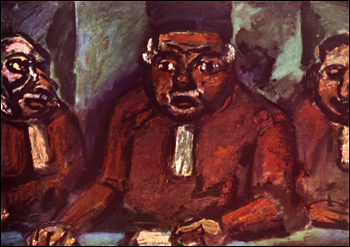
Georges Rouault, Three Judges, 1913



